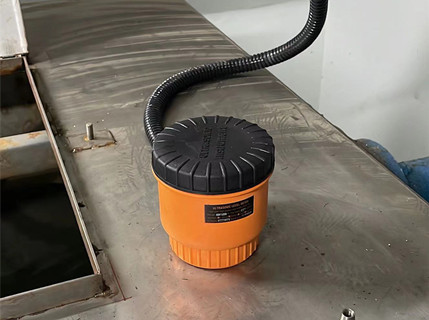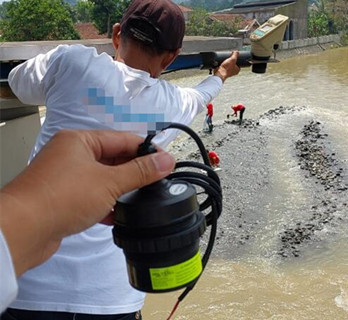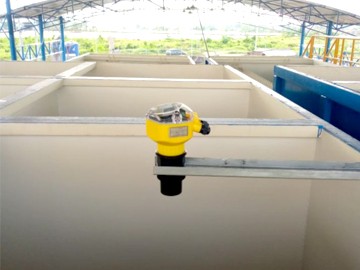Common Faults and Troubleshooting of Ultrasonic Liquid Level Sensor
Ultrasonic level gauges are widely used in the measurement of various liquids and solids. The following are common faults and solutions for ultrasonic level gauges.
No.1:There is electromagnetic interference on site.
Failure
The data of the ultrasonic level sensor fluctuate irregularly, or there is no signal.
Cause
There are motors, frequency converters and electric welding in the industrial site. Electromagnetic interference affects the echo signal received by the probe.
Solution
1.The ultrasonic level sensor must be reliably grounded. After grounding, some interference on the circuit board will disappear through the ground wire, and this ground wire must be grounded separately, and cannot share a ground wire with other devices.
2.The power supply cannot be the same as that of the frequency converter and motor, nor can it be directly drawn from the power system.
3.The installation site should be far away from frequency converters, variable frequency motors, and high-power electrical equipment. If it cannot be kept away, a metal instrument box should be installed outside the sensor for isolation and shielding, and the instrument box should also be grounded.

No.2:There is stirring in the container, and the liquid fluctuates greatly, which affects the measurement of the ultrasonic liquid level gauge.
Failure
No signal or great data fluctuations.
Cause
The measurement distance of ultrasonic level sensors refers to the distance to the calm water surface. For example, an ultrasonic level sensor with a measuring range of 5m generally indicates that the maximum distance for measuring calm water is 5m, and it will reach 6m when it leaves the factory. When there is agitation in the container, the water surface is not calm, and the reflected signal will be weakened to less than half of the normal signal.
Solution
1.Choose an ultrasonic liquid level sensor with a larger range. If the actual range is 5m, use a 10m or 15m.
2.Or if the liquid in the tank is non-viscous, a waveguide can be installed, and the probe is placed in the waveguide to measure the height of the liquid level since the liquid level in the waveguide is basically stable. 3.It is recommended to change the two-wire ultrasonic liquid level sensor to a four-wire system.
No.3:There is foam on the surface of the liquid.
Failure
The ultrasonic level gauge keeps searching, or displays the state of Wave loss。
Cause
The foam absorbs the ultrasonic waves significantly, resulting in a very weak echo signal. Therefore, when more than 40-50% of the liquid surface is covered by foam, most of the signals sent by the ultrasonic level gauge will be absorbed, causing signal receiving failure. This has nothing to do with the thickness of the foam, but mostly with the area covered by the foam.
Solution
1.Install the waveguide, put the probe in it to measure the height of the level, since the foam in the waveguide will be much reduced.
2.Use radar level sensor instead. Radar level gauge can penetrate foam within 5 cm.

No.4:The temperature in the tanks is high, which affects the measurement.
Failure
When the water surface is close to the probe, it can be measured, but when the water surface is far away from the probe, it cannot be measured. When the water temperature is low, it measures normally, but when the water temperature is high, it cannot measure.
Cause
The liquid generally does not produce steam and mist below 30-40°C. Above this temperature, it is easy to produce steam or mist. The ultrasonic wave emitted will be attenuated by the steam once during the emission and reflected back from the liquid surface. When it attenuates again, the ultrasonic signal returning to the probe is very weak, so it cannot be measured. Moreover, in this environment, the probe is prone to water droplets, which will affect the transmission and reception of ultrasonic waves.
Solution
1.Increase the range. For example, if the actual height of the tank is 3m, an ultrasonic level sensor with 6m to 9m range can be selected., which can reduce the influence of steam or mist on the measurement. 2.Use polytetrafluoroethylene or polyvinylidene fluoride probes. In this way, water droplets are not easy to condense on the emitting surface of the probe, and are more likely to condense on the emitting surface of other materials.
No.5 Ultrasonic wave enters the blind zone
Failure
Full scale or arbitrary data appear.
Cause
The ultrasonic liquid level sensor has a blind zone, generally for 5m measuring range, and the blind zone is 0.3m-0.4m, and 0.4m-0.5m for 10m measuring range. After the ultrasonic wave enters the blind zone, there will be arbitrary values and it will not work properly.
Solution
The height of the blind zone must be considered during installation. The distance between the probe and the highest water level must be greater than the blind zone.
The above may cause the ultrasonic liquid level gauge failure. It is recommended that the user inform us of the specific working conditions when purchasing, so that our engineers can select the right model for you.






